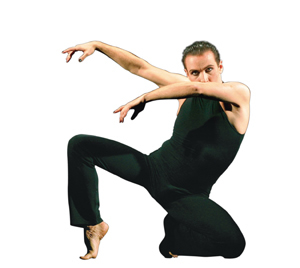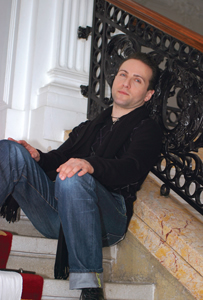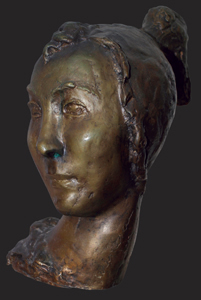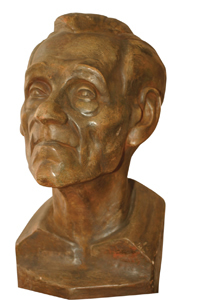MOVING WITH THE TIMES
 Taking easy steps has never been the
desired route for contemporary dancer
and choreographer Razvan Mazilu.
Taking easy steps has never been the
desired route for contemporary dancer
and choreographer Razvan Mazilu.
Despite praise in Moscow, Athens,
Paris and London, being presented
awards by Jacques Chirac’s wife and the
fact that Romanian born dancers have
dazzled crowds abroad, Mazilu has set
up his stage in Bucharest.
And he is not about to leave.
“You can make high quality art anywhere
you are. If you have valuable
ideas, if you have a vision and if you
fight for it,” the 31 year-old dancer says.
“Leaving the country is not a solution – this will not make an artist more
valuable or more original. But I always
choose the difficult options anyway. I’d
like to think that I am one of the artists
who are writing the history of the art of
dance in Romania as we speak. At least
a little bit of it.”
As a lead, Mazilu put on the first ever
one-man show by a Romanian dancer, ‘Playing Shakespeare’, where he embodied
in dance Richard III, Hamlet,
Falstaff and Othello, while his current
show is a theatre-and-dance version of
Oscar Wilde’s ‘The Picture of Dorian
Gray’ at Teatrul Odeon. Throughout
the performance, Mazilu remains silent,
communicating through movement the
descent of the Faustian antihero
from eternal youth to damnation.
“Nothing seems to me more
natural and more beautiful than
turning words into gestures, into
moves,” he says. “I’ve wanted to
do this character for a long time,
I felt it was a great opportunity for
an artist – his combination of ugliness
and beauty – all intrigued me
and inspired me.”
Now he is taking on Berlioz.
‘Fantastica’ at the Bucharest National
Opera House will be a
contemporary ballet, to music by
the French composer, charting
the conflicts between the public
and private lives of an artist, with
Mazilu in the lead.
Turn-of-the-century Paris inspires
the dancer. The period of
art for art’s sake, cabaret, absinthe,
Diaghilev’s Ballet Russes, where
everything was art and everything
was nouveau, even soap packaging
and signs for the Metro.
 “I always follow my belief that barriers
need to be broken,” he says. “I like
to innovate, to find new artistic expressions,
not because I want to shock people
but because I do believe in art’s capacity
to always re-invent itself.”
“I always follow my belief that barriers
need to be broken,” he says. “I like
to innovate, to find new artistic expressions,
not because I want to shock people
but because I do believe in art’s capacity
to always re-invent itself.”
Contemporary dance in Romania
lacks a precedent. In the 1960s and
1970s state-sponsored classical ballet
in Bucharest was much acclaimed,
while the authorities saw contemporary
dance as too decadent. Censorship was
also no help. However, with the end of
Communism, both ballet styles fight for
survival.
Mazilu puts hope in a new National
Dance Centre which aims to showcase
contemporary works.
“It is possible to stage dance shows in
Romania,” he says, “because what matters
most is a strong idea and the passion
that makes it come to life.”
But, without sponsorship, theatre in
a free market economy is vulnerable to
closure.
“I believe there is money in Romania
that can be directed towards art,” adds
Mazilu. “What is maybe lacking is the
interest and belief that it is worth investing
this money into art, that genuine art
is or can be a profitable investment.”
Michael Bird
‘Fantastica’, a spectacle based on
Berlioz’s ‘Symphonie Fantastique’ with
Razvan Mazilu and prima ballerina
Corina Dumitrescu opens on 17 and 18
March 2006 at the Bucharest National
Opera, 70-72 Blvd Mihai Kogalniceanu
STATE SECRET
 Dodging cars parked on the pavement
and evidence of recent dog-walks on
the narrow and crowded Strada Maria
Rosetti, it is easy to pass the ‘Vasile Grigore’
Art Museum without bothering to
acknowledge its existence.
Dodging cars parked on the pavement
and evidence of recent dog-walks on
the narrow and crowded Strada Maria
Rosetti, it is easy to pass the ‘Vasile Grigore’
Art Museum without bothering to
acknowledge its existence.
The dusty but intriguing facade hides
spacious and whitewashed rooms where
one can find something Bucharest’s residents
seem to have forgotten about: fine
taste, simple elegance and serenity.
A recent addition
to the state’s
collection of small
galleries, this museum
opened in
2004, when artist
Vasile Grigore donated to his country
this remarkable collection of Romanian
inter-bellum and modern paintings,
Romanian folk art, European and Far-
Eastern decorative art works, pieces of
furniture and antique kitchenware.
More than 600 pieces of diverse and
surprising beauty have been moved from
the artist’s apartment and work studio to
this delightful residence.
The works are displayed over two
floors and five exhibition rooms, though
this term sounds somewhat inappropriate.
They are too intimate and pleasant.
One does not find in ‘exhibition’ spaces
classical music in the background and
friendly and helpful staff who know
the works and their history, as one can
here.
Entering the first wide hall, it already
feels at home between the paintings of
Ciucurencu, Pallady and Corneliu Baba,
as well as Irimescu’s sculptures.
 Nearby, there are Japanese vases,
Russian plates, Turkish brass,
Biedermeier, Meissen, Jugendstil
and art nouveau teapots and trays
on Louis XV furniture.
Nearby, there are Japanese vases,
Russian plates, Turkish brass,
Biedermeier, Meissen, Jugendstil
and art nouveau teapots and trays
on Louis XV furniture.
Make sure your feet beware of
the two carpets that are also part
of the exhibition. If you are from
Oltenia, they may have been made
by your grandmothers’ great-great-greatgrandmother.
The walls of the
staircase are also
covered with
works of art. On
this upper, superior
floor are two big surprises: a
room for Romanian folk art room
on one side and Japanese prints on
the either. Imagine the impact of
a looking at a geisha straight after
a naivist Madonna icon on glass.
Shall I be excommunicated if I
find a resemblance in the beauty
and fragility in both?
‘Vasile Grigore’ does not give
the impression of being a museum
and despite the variety of styles and
sources of the exhibits, it is far from a
tasteless bazaar.
The most irritating things about cliches
are that they are often true. Yet
the ‘Vasile Grigore’ Art Museum
is one of “Bucharest’s best kept
secrets” and “an oasis of
beauty and tranquility”.
Anca Pol
‘Vasile Grigore’ Art Museum is on 29 Str Maria Rosetti, opened
Tuesday to Sunday, 9:00 to 17:00 hrs
